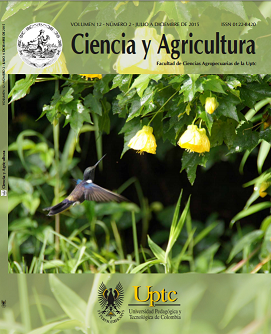Effect of dietary supplementation with Morinda citrifolia on productivity and egg quality of laying hens

Abstract
In order to evaluate the dietary supplementation of powdered leaves of Morinda citrifolia on productivity and egg quality of laying hens, a total of 160 White Leghorn birds (Hybrid L-33) of 27 weeks of age were allotted during 70 days, according to completely randomized design. Dietary treatments consisted of a control diet fed without or with 0.5, 1.0 and 1.5% of powdered leaves of M. citrifolia. Supplementation of 1.0 and 1.5% of M. citrifolia powder increased the egg weight (P<,0.05), however, laying intensity, body weight, feed intake, unsuitable eggs, eggshell surface, mass conversion, haugh units and height of the dense white and of the yolk showed no significant differences (P>,0.05) among treatments. Also, supplementation of 0.5 and 1.0% of M. citrifolia increased the shell thickness and the yolk color was pigmented by this medicinal plant. It recommended the dietary supplementation of 1.0% of powdered leaves of M. citrifolia on laying hen diets to improve the egg weight, shell thickness and yolk color.
Keywords
egg, laying hen, noni, productivity, quality
References
- Kong X. F., Y. L. Hu, and R. Rui (2004). Effects of Chinese herbal medicinal ingredients on peripheral lymphocyte proliferation and serum
- antibody titer after vaccination in chicken. Int. Immunopharmacol. 4(7): 975-982. DOI: http://dx.doi.org/10.1016/j.intimp.2004.03.008.
- Ghasemi R., M. Zarei, and M. Torki (2010). Adding medicinal herbs including garlic (Allium sativum) and thyme (Thymus vulgaris) to diet of laying hens and evaluating productive performance and egg quality characteristics. American J. Animal Vet. Sci. 2(2): 151-154. DOI: http://dx.doi.org/10.3844/ajavsp.2010.151.154.
- Wang M. Y., B. J. West, C. J. Jensen, D. Nowicki, C. Su, A. K. Palu, and G. Anderson (2002). Morinda citrifolia (Noni): a literature review and recent advances in Noni research. Acta Pharmacol. Sin. 23: 1127-1141.
- Brito D. R., R. M. Fernandes, M. Z. Fernandes, M. D. Ferreira, F. R. Rolim, and M. L. Filho (2009). Anthelmintic activity of aqueous and ethanolic extracts of Morinda citrifolia fruit on Ascaridia galli. Rev. Bras. Parasitol. Vet. 18(4): 32-36. DOI: http://dx.doi.org/10.4322/rbpv.01804006.
- Unión Estatal del Centro Avícola Nacional (UECAN) (2011). Manual tecnológico para la cría de aves. Ponedoras y sus reemplazos. 5nd Ed Ministerio de la Agricultura (Havana). 9 p.
- Aguilar Y., O. Martínez, G. Liu, W. Ren, R. Bertot, Y. Jiménez, C. González, M. del Toro, A. Ginarte, M. Navarro, and C. M. Nyachoti (2013). Effect of dietary supplementation with Anacardium occidentale on growth performance and immune and visceral organ weights in replacement laying pullets. J. Food Agric. Environ. 13(3&4): 1352-1357.
- Martínez Y., A. Escalona, O. Martínez, C. Olmo, R. Rodríguez, M. Iser, C. Betancur, M. Valdivié, and G. Liu (2012). The use of Anacardium occidentale as nutraceutical in hypoprotein diets for laying hens. Cuban J. Agricult. Sci. 46(4): 395-401.
- Savón L., I. Scull, and M. Martínez (2007). Integral foliage meal for poultry feeding. Chemical composition, physical properties and phytochemical screening. Cuban J. Agricult. Sci. 41(2): 359-361.
- Pazmi-o-Duran E. A., M. M. Giusti, R. E. Wrolstad, and M. B. Gloria (2001). Anthocyanins from banana bracts (Musa paradisiaca) as potential food colorants. Food Chem. 73(3): 327-332. DOI: http://dx.doi.org/10.1016/S0308-8146(00)00305-8.